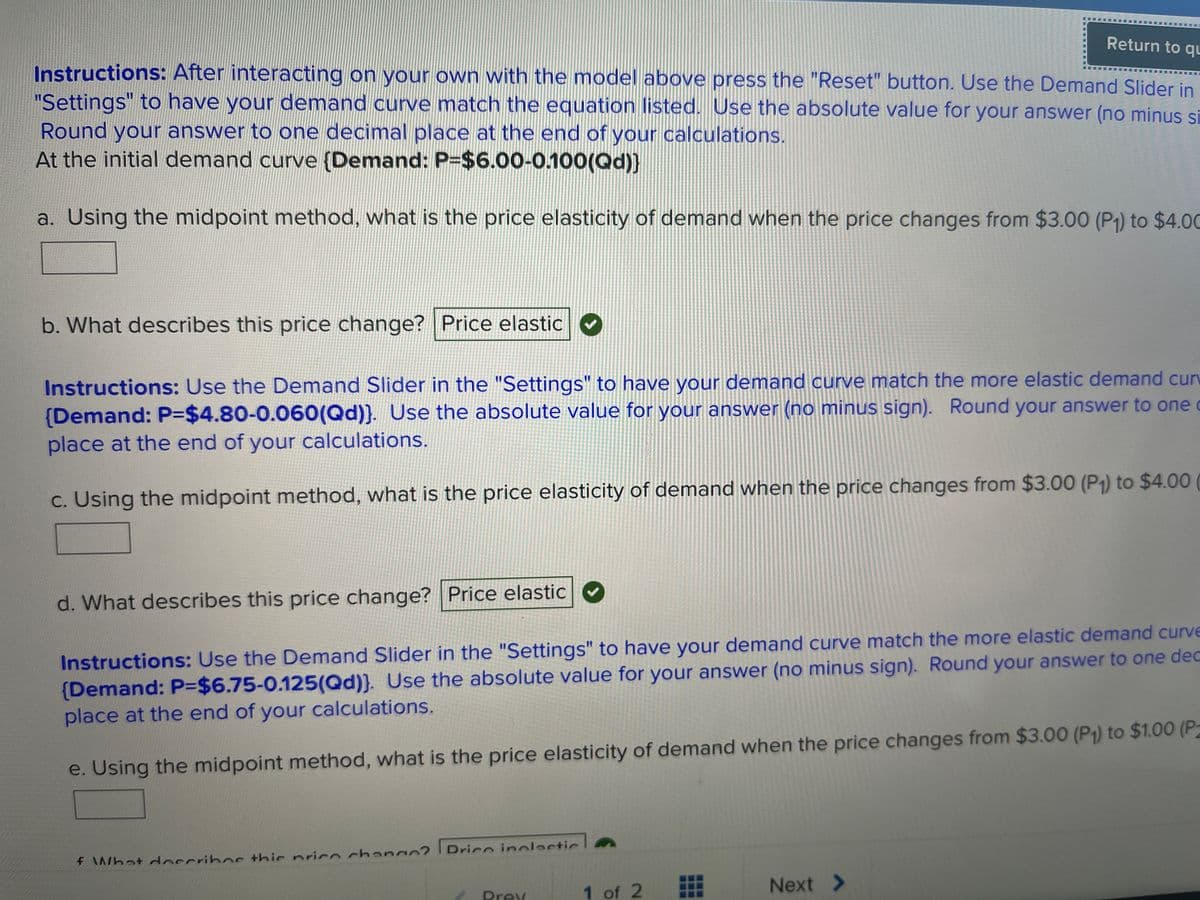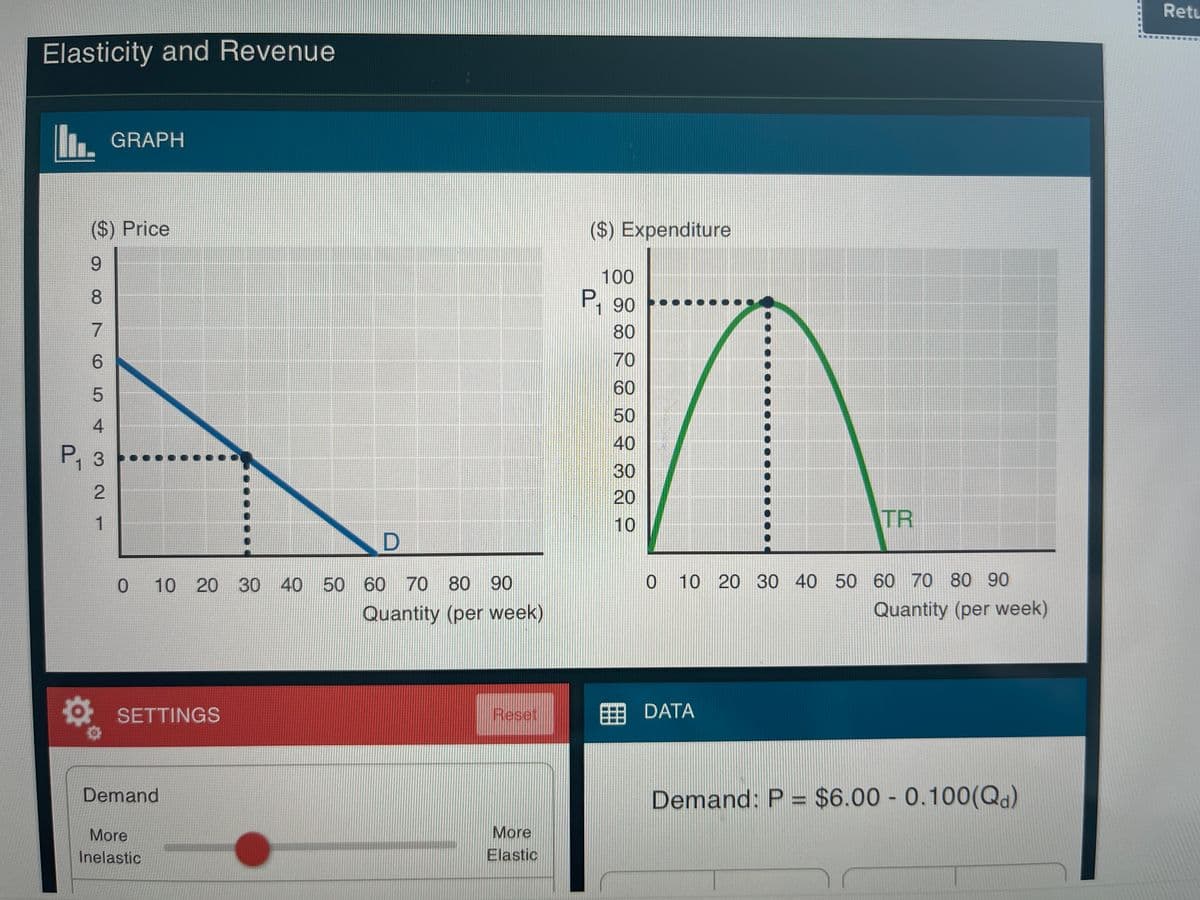a. Using the midpoint method, what is the price elasticity of demand when the price changes from $3.00 (P1) to $- b. What describes this price change? Price elastic Instructions: Use the Demand Slider in the "Settings" to have your demand curve match the more elastic demand (Demand: P=$4.80-0.060(Qd)). Use the absolute value for your answer (no minus sign). Round your answer to o place at the end of your calculations. c. Using the midpoint method, what is the price elasticity of demand when the price changes from $3.00 (P₁) to $4. d. What describes this price change? Price elastic Instructions: Use the Demand Slider in the "Settings" to have your demand curve match the more elastic demand c (Demand: P=$6.75-0.125(Qd)). Use the absolute value for your answer (no minus sign). Round your answer to one place at the end of your calculations. from $3.00 (P₁) to $1.00
a. Using the midpoint method, what is the price elasticity of demand when the price changes from $3.00 (P1) to $- b. What describes this price change? Price elastic Instructions: Use the Demand Slider in the "Settings" to have your demand curve match the more elastic demand (Demand: P=$4.80-0.060(Qd)). Use the absolute value for your answer (no minus sign). Round your answer to o place at the end of your calculations. c. Using the midpoint method, what is the price elasticity of demand when the price changes from $3.00 (P₁) to $4. d. What describes this price change? Price elastic Instructions: Use the Demand Slider in the "Settings" to have your demand curve match the more elastic demand c (Demand: P=$6.75-0.125(Qd)). Use the absolute value for your answer (no minus sign). Round your answer to one place at the end of your calculations. from $3.00 (P₁) to $1.00
Managerial Economics: A Problem Solving Approach
5th Edition
ISBN:9781337106665
Author:Luke M. Froeb, Brian T. McCann, Michael R. Ward, Mike Shor
Publisher:Luke M. Froeb, Brian T. McCann, Michael R. Ward, Mike Shor
Chapter6: Simple Pricing
Section: Chapter Questions
Problem 6.1IP
Related questions
Question

Transcribed Image Text:Return to qu
Instructions: After interacting on your own with the model above press the "Reset" button. Use the Demand Slider in
"Settings" to have your demand curve match the equation listed. Use the absolute value for your answer (no minus si
Round your answer to one decimal place at the end of your calculations.
At the initial demand curve {Demand: P=$6.00-0.100(Qd))
a. Using the midpoint method, what is the price elasticity of demand when the price changes from $3.00 (P₁) to $4.00
b. What describes this price change? Price elastic ✔
Instructions: Use the Demand Slider in the "Settings" to have your demand curve match the more elastic demand cur
(Demand: P-$4.80-0.060(Qd)). Use the absolute value for your answer (no minus sign). Round your answer to one c
place at the end of your calculations.
c. Using the midpoint method, what is the price elasticity of demand when the price changes from $3.00 (P₁) to $4.00
d. What describes this price change? Price elastic
Instructions: Use the Demand Slider in the "Settings" to have your demand curve match the more elastic demand curve
(Demand: P=$6.75-0.125(Qd)). Use the absolute value for your answer (no minus sign). Round your answer to one dec
place at the end of your calculations.
e. Using the midpoint method, what is the price elasticity of demand when the price changes from $3.00 (P₁) to $1.00 (P2
f What describes this price change? Drico inolactic
Prev
1 of 2
E
Next >

Transcribed Image Text:Elasticity and Revenue
($) Price
9
87854
6
GRAPH
P₁ 3
2
1
0
10 20 30 40 50 60 70 80 90
Quantity (per week)
SETTINGS
Demand
More
Inelastic
Reset
More
Elastic
($) Expenditure
100
1 90
80
70
60
50
40
30
20
10
P₁
TR
0 10 20 30 40 50 60 70 80 90
DATA
Quantity (per week)
Demand: P = $6.00 - 0.100(Qd)
Retu
Expert Solution
This question has been solved!
Explore an expertly crafted, step-by-step solution for a thorough understanding of key concepts.
This is a popular solution!
Trending now
This is a popular solution!
Step by step
Solved in 4 steps

Knowledge Booster
Learn more about
Need a deep-dive on the concept behind this application? Look no further. Learn more about this topic, economics and related others by exploring similar questions and additional content below.Recommended textbooks for you

Managerial Economics: A Problem Solving Approach
Economics
ISBN:
9781337106665
Author:
Luke M. Froeb, Brian T. McCann, Michael R. Ward, Mike Shor
Publisher:
Cengage Learning

Managerial Economics: A Problem Solving Approach
Economics
ISBN:
9781337106665
Author:
Luke M. Froeb, Brian T. McCann, Michael R. Ward, Mike Shor
Publisher:
Cengage Learning